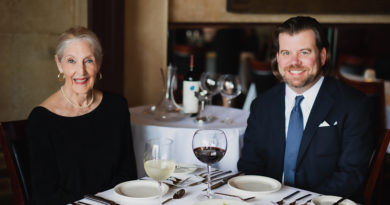Dr. Shona Ahuja brings world of knowledge to patients in Harker Heights
By Tonya Warren | Photos by Justin Borja
Wellstone Health Partners at Seton Medical Center Harker Heights welcomed Dr. Shona Ahuja to the staff roster on an unseasonably rainy day this summer. Cloudy skies didn’t dampen spirits of the new doctor, and her umbrella hadn’t yet dried before she began seeing her first patients. Not one to get cold feet, Ahuja was empowered on the new job; after all, she’d just taken care of Temple VA patients full time during the pandemic via telemedicine.
Born into a traditional family in Hyderabad, India, Ahuja’s father and partners owned a gas station to support his large extended family. Her mother was a homemaker who saw to the day-to-day needs of the family, including Ahuja and her two older sisters.
Soft-spoken Ahuja excelled in school and wanted to expand her horizons past traditional norms. “Growing up, I saw how my aunts who were doctors helped everyone and were well-respected,” she said. “Education was important to my grandmother and father.”
Ahuja obtained her undergraduate and medical degrees from Siddhartha Medical College in Vijayawada, India, where the urban setting provided her ample opportunity to study various specialties and focus on the one that piqued her interest. Upon graduation, she immigrated to the United States where she trained in the Christ Hospital program of internal medicine at the University of Illinois in Chicago. Ahuja developed a passion for internal medicine, and after moving to Central Texas, she worked for the Department of Veterans Affairs before joining Wellstone at Seton.
According to 2015 American Medical Association statistics, there are a little over 114,000 internal medicine doctors in the United States. Ahuja wanted to specialize in this particular area because she wanted to fundamentally create positive changes for people. Many of her patients have COPD (chronic obstructive pulmonary disease), diabetes or other chronic ailments such as high blood pressure and high cholesterol.
“I also enjoy the challenges of internal medicine,” she said. “Listening to patient symptoms, critically analyzing causes of symptoms and encouraging patients to safeguard their health are important aspects of their care.”
Working like a detective, internal medicine doctors must consider the whole patient picture. For example, a patient with high blood sugar levels might have a foot ulcer not healing properly. The foot ulcer might then cause the patient pain when walking. Uncontrolled pain can then cause increased blood pressure, which in turn adds stress to the body, hindering the patient’s ability to achieve a healthy outcome.
Ahuja believes patients benefit most from the health care system when they are active participants in their own care, and individualized care plans are created by the doctor and patient, as health care goals are discussed during the visit. Common areas of concern include weight management and preventive care such as smoking cessation. Of continual concern to doctors are patients putting off cancer screenings such as colonoscopies and mammograms due to the fear of COVID-19 transmission. But preventive screenings and discussing concerns with their doctor contribute to early cancer detection which saves more lives.
Like any profession, medicine has its own set of challenges, but in this one, lives are at stake. Medicine is more than hurrying into an exam room and sitting down in front of a computer screen. Compassionate and competent care takes time and shortcuts don’t produce the best results.
When asked what gives Ahuja the most satisfaction in being a doctor, she said, “It’s when my patients receive accurate diagnoses and treatments, and they get better in every way.”
Complex health care systems, uninsured and underinsured patients can prove challenging, and Ahuja acknowledged the most challenging aspect for her is when patients are unable to afford needed treatments, medications or tests because they do not have the adequate money or coverage.
“Chronic disease may be destroying their health and trying to get them the care they need is a struggle,” Ahuja said.
Ahuja believes one practical way a patient can get the most out of their doctor’s visit is to come prepared. Be on time for the appointment and have paperwork completed, if possible, before the day of the visit. Bring a complete list of all current medications you take, both prescription and over-the-counter medications. Be sure to include dosages and frequency of each medication. Have questions or concerns written down ahead of time so they may be promptly discussed. Using a cellphone to take picture of an area of concern, such as skin rash and how it’s changed, may be beneficial in showing the doctor during the appointment. Bring items that might need to be checked by the staff for accuracy such as a blood sugar monitor. Be truthful about lifestyle habits such as smoking, alcohol intake, illicit drugs and sexual partners. Honesty assists the doctor in knowing how to begin educational/preventive discussions to keep the patient healthy. Also, take notes or record on a cellphone what is discussed so it can be referred to later. Consider bringing a loved one or trusted friend; they may hear something said during the visit that might otherwise be overlooked.
When she’s not busy with work, Ahuja enjoys spending time with her husband, who is also a doctor, and their three sons. The two younger sons have expressed an interest in following in their parents’ career choices.
Ahuja says she’s grateful to her adopted country for its freedom and independence. She encourages others to enjoy each moment of life and appreciate the ripple effect kindness brings. Those words are medicine that calms the mind and soothes the soul, and best yest, no prescription is needed.




